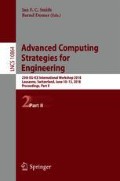Abstract
The paper advocates the use of Linked Data approaches as a means of overcoming the limitations of conventional monolithic data modeling in the context of the de-facto heterogeneity of information systems and data models in the diverse fields of the digital built environment. It enriches the discussion by focusing on one specific sub-domain – the application of digital methods in road design, construction and operation which involves the exchange, management and querying of spatio-semantic data that typically stems from different data sources and involves diverse software systems and data models. It argues that semantic web techniques significantly simplify the integration of heterogeneous data models. In a case study, the German road data exchange standard OKSTRA is linked with the Dutch CB-NL and RWS object type libraries. Doing so, it is shown how nationally well-established and widespread standards can be integrated in order to perform cross-country querying of road data. As a basis for the cases study, OKSTRA was transferred into an OWL-based data format, resulting in the creation of okstraOWL. The paper discusses in detail strategies for realizing semi-automated mapping with the Dutch CB-NL and RWS object type library, including a detailed analysis of the advantages and limitations of the different options. Major emphasis is placed on finding spatially related entities. Finally, the paper discusses the capabilities of linking the data sets by presenting a number of exemplary SPARQL queries for answering real-world questions that require the integrated analysis of data sets in different data models.
Access this chapter
Tax calculation will be finalised at checkout
Purchases are for personal use only
References
Amor, R., Jiang, Y., Chen, X.: BIM in 2007 - are we there yet. In: Proceedings of CIB W78 Conference on Bringing ITC Knowledge to Work, Maribor, Slovenia, pp. 26–29 (2007)
Laakso, M., Kiviniemi, A.: The IFC standard - a review of history, development and standardization. ITcon J. Inf. Technol. Constr. 17, 134–161 (2012)
Bizer, C., Heath, T., Berners-Lee, T.: Linked data - the story so far. In: Semantic Services, Interoperability and Web Applications: Emerging Concepts, pp. 205–227 (2009)
Bizer, C., Lehmann, J., Kobilarov, G., Auer, S., Becker, C., Cyganiak, R., Hellmann, S.: DBpedia - a crystallization point for the web of data. Web Semant.: Sci. Serv. Agents World Wide Web 7(3), 154–165 (2009)
Open Geospatial Consortium: Geographic information - well-known text representation of coordinate reference systems (2015)
Open Geospatial Consortium: GeoSPARQL - a geographic query language for RDF data (2012)
ISO10303-11:1994: Industrial automation systems and integration - Product data representation and exchange - Part 11: description methods: the EXPRESS language reference manual (1994)
Object Management Group: XML Metadata Interchange (XMI) Specification (2015)
Amann, J., Singer, D., Borrmann, A.: Extension of the upcoming IFC alignment standard with cross sections for road design. In: Proceedings of the ICCBEI 2015, Tokyo, Japan (2015)
Amann, J., Borrmann, A.: Embedding procedural knowledge into building information models: the IFC Procedural Language and its application for flexible transition curve representation. J. Comput. Civ. Eng. 30(4), 1–14 (2016)
Willems, P., Schaap, H.: COINS 1.1 specs (Release 15/12/2014) - CoinsWiki
Krima, S., Barbau, R., Fiorentini, X., Sudarsan, R., Sriram, R.D.: Ontostep: OWL-DL ontology for STEP. National Institute of Standards and Technology, NISTIR 7561 (2009)
Beetz, J., van Leeuwen, J., de Vries, B.: IfcOWL: a case of transforming EXPRESS schemas into ontologies. AI EDAM 23, 89–101 (2009)
Pauwels, P., Terkaj, W.: EXPRESS to OWL for construction industry: towards a recommendable and usable ifcOWL ontology. Autom. Constr. 63, 100–133 (2016)
Hettwer, J., Portele, C.: T0006 Ableitung von OKSTRA®-XML aus der EXPRESS-Modellierung (2011)
Drummond, N., Rector, A.L., Stevens, R., Horridge, Moulton, G., Wang, H.G., Seidenberg, J.: Putting OWL in order: patterns for sequences in OWL. In: Proceedings of 2nd OWL Experiences and Directions Workshop, Athens (2006)
Pauwels, P., Terkaj, W., Krijnen, T., Beetz, J.: Coping with lists in the ifcOWL ontology. In: 22nd EG-ICE International Workshop, pp. 113–122 (2015)
Zheng, Y.: Improving the interoperability between city and infrastructure information. Integrating CityGML and OKSTRA data based on semantic web and linked data technology. Master’s thesis, Eindhoven University of Technology (2017)
Acknowledgments
The authors would like to thank J. Amann (TUM) and Y. Zheng (TUE) for their efforts in developing software prototypes implementing the concepts and case studies presented.
The research presented in this paper has been funded by the German Federal Highway Research Institute (BASt) under grant FE 01.0195/2015/AGB.
Author information
Authors and Affiliations
Corresponding author
Editor information
Editors and Affiliations
Rights and permissions
Copyright information
© 2018 Springer International Publishing AG, part of Springer Nature
About this paper
Cite this paper
Beetz, J., Borrmann, A. (2018). Benefits and Limitations of Linked Data Approaches for Road Modeling and Data Exchange. In: Smith, I., Domer, B. (eds) Advanced Computing Strategies for Engineering. EG-ICE 2018. Lecture Notes in Computer Science(), vol 10864. Springer, Cham. https://doi.org/10.1007/978-3-319-91638-5_13
Download citation
DOI: https://doi.org/10.1007/978-3-319-91638-5_13
Published:
Publisher Name: Springer, Cham
Print ISBN: 978-3-319-91637-8
Online ISBN: 978-3-319-91638-5
eBook Packages: Computer ScienceComputer Science (R0)

